Winter is approaching quickly, and with it the leaves are falling from the trees. That means a whole bunch of activities is over for this year – observing bees, butterflies, flowering plants, mushrooms, and many more. Winter just puts its drab foggy hibernation coat over almost everything. Almost, because as every year suddenly I start to see more birds again and my love for bird watching (and in my case bird drawing) is rekindled.
This post was meant as a short preface to a practical guide on how to start birding, but it ended up so long that I decided to make it an individual post. Apparently my love of birds has provided me with so many reasons to start bird-watching that they don’t fit into a few sentences. You can, of course, exchange birding with any other activity in nature, because all of the living things out there are worth observing and learning more about, and there are likely to be nerdy specialists for each topic and species. For me, it happens that birds are special. Read on why.
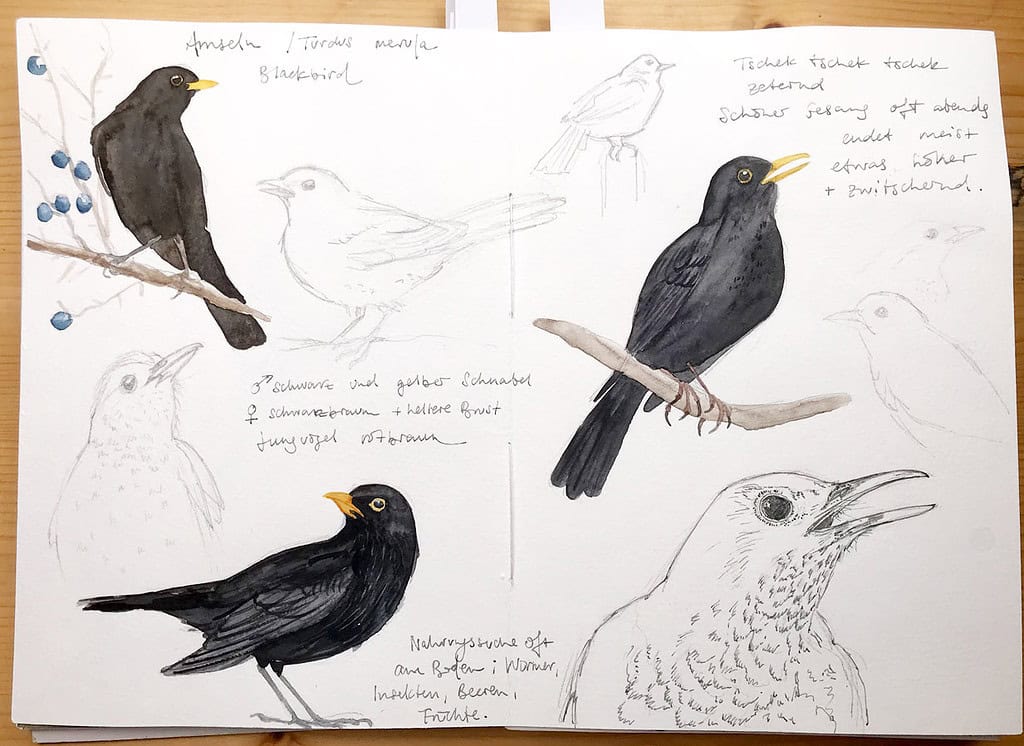
I probably don’t need to persuade you if you’ve been around for a while and share my passion for nature and birds (I know a lot of you do!), but I know from time to time this blog is visited by people new to nature observation or sketching (welcome!), and they might not know yet why birds are such wonderful, weird creatures that are worth your time. Let’s invite them, because they absolutely need to know!
I think what I like most about birding is that it takes you into the life of a wild creature instantaneously. Birds don’t mind having humans around (at a safe distance) because they can depart at any second, and so they will simply do their bird thing in front of you: flying, perching, socializing, fighting, feeding, preening, nest-building, mating, hunting – it’s all there for you to observe if you want. I can be part of almost every quarrel over food that my local sparrows are fighting, and they don’t mind me hanging out behind the window. You won’t get that level of easy observation from any wild mammal – they need to hide to survive because they can’t simply fly away. Birds, on the other hand, can be observed almost everywhere, often they behave in a way you can’t miss them anyway, and if we’re careful around them we won’t disturb them. Birds that live near humans will even interact with you if you don’t pose a danger (I’m surely anthropomorphizing here, but my sparrows seem to be cocking their heads in my direction more often when the feeders are empty. They demand their food.).
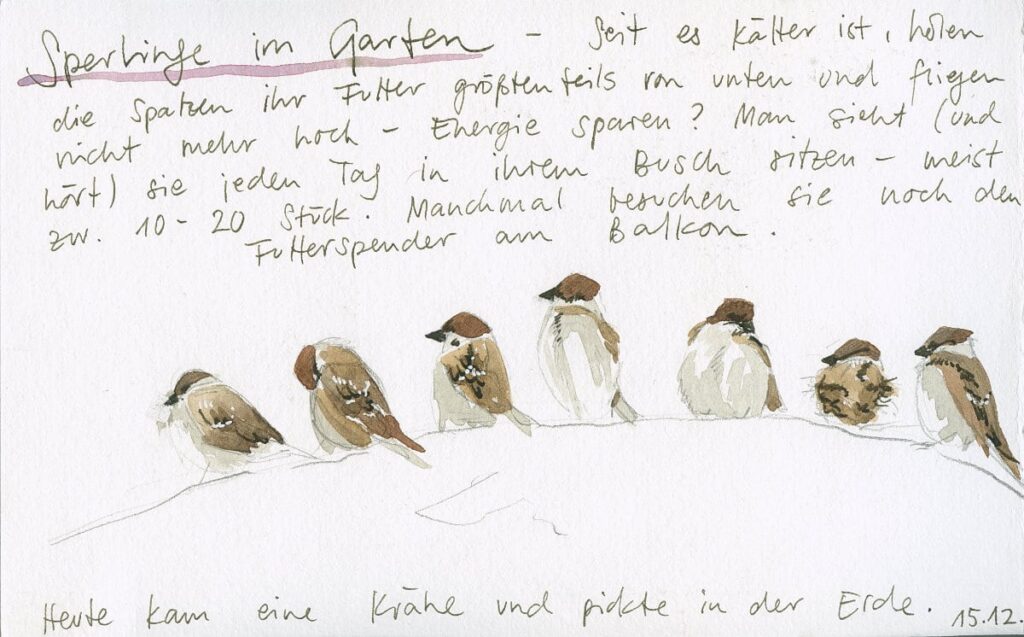
Birdwatching for me is an activity that takes me into another situation in an instant, away from thoughts and any sorrows – nature generally gives me a lot of solace and calm and excitement, and when I grab my binoculars or my camera I forget about all of the normal stresses and worries of my adult life for a while (and all of the pandemic stress we had in the last two years on top of that). Nature can do that for you, all for free.
Whether you’re new to birding or have done it for years, there’s always something new to learn and to see. Whether it’s a new species or a new behaviour or a new place. Watching birds in their habitat means observing a part of a living, dynamic ecosystem, and things are never static in nature. You can learn a great deal about the world we live in that way, and you don’t need a scientific background – a love for nature and curiosity is enough and the rest will come. Birding is active learning. You can get to know the world around you through birding. Even if it’s just the hierarchy of different birds at your feeder (our small garden birds usually respect larger sized birds, but there is one small feisty blue tit that stands its ground against much larger sparrows and nuthatches).
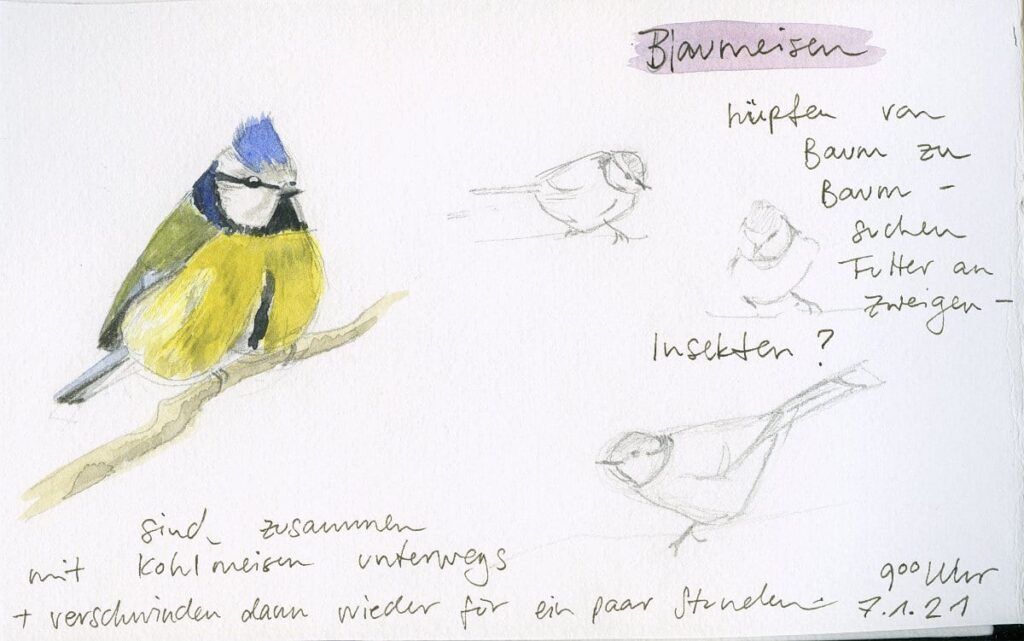
As a side note: Usually, when you pick up one special interest surrounding nature, others will follow. I’m an orchid and butterfly nerd myself in addition to being a birder, and I always try to learn as much as I can from any place in nature. Observing nature can keep you busy for your entire life.
Birding can form connections to others about a shared topic. A lot of people love birds or have a feeder in their garden, so even if they don’t know a lot about them it’s nice to share experiences and connect. In non-pandemic times there are also a lot of local bird-watching groups or offers by local nature conservation centers to go birding together, and these regular meet-ups with fellow birders can build wonderful connections. And as a personal anecdote, it’s very likely that you will make your spouse a birder over time if you just keep talking about birds all the time like a mad person (which you will inevitably start to do), point excitedly at them whenever possible, and install a feeder or two. Birds will win over the heart of almost anyone, and they don’t even know, the little dinosaurs.
All in all, birdwatching is easy, accessible and fun, and as we will see you don’t need a lot of equipment for it. I will talk more about specific equipment and how to get started in the next post, but essentially you don’t need anything special for this wonderful pastime. Basically a reference guide and a small pair of light binoculars should be enough. I take things a bit further because I often sketch the birds I see, but that’s only the next step if you’re really interested and enjoy drawing. If you just want to familiarize yourself with the birds around you, just start looking out of the window, or when you’re on a walk, and observe the birds and enjoy it – there, you’re a birdwatcher. Don’t let anyone tell you otherwise because you don’t keep lists (I don’t) or don’t have the best binoculars (I definitely don’t).
I hope you enjoyed this personal ode to birding. I’d love to hear back from you – do you watch birds, and what does birding do for you? And maybe, if you haven’t done any bird-watching yet, I’d love to hear from you someday that you tried it out.



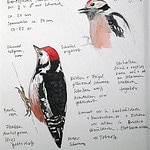
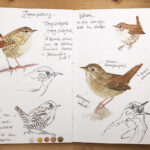
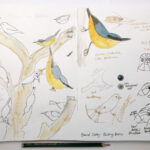
This is a delightful and joyful description of bird watching. And all true, including the sneaky way that this crazy enthusiasm gets spouses interested in noticing birds!!!
Thank you Jaci! Yes! No-one was more surprised than me that this actually did work. I’m even handed close-up bird shots now from time to time (“while you were looking at butterflies back there I took some photos”). 😉
I discovered birding several years ago and, like you, I find them to be an endless source of interest and joy!
Thank you for a lovely post.
Thank you Liz!
Thanks for reminding us that some birds are with us all year.
Wishing you a Happy Thanksgiving.
Thank you, I wish you a Happy Thanksgiving too! 🙂
I enjoy birding. It enjoyable and interesting. I want to learn more about drawing them. Thanks and enjoy the holidays.
Thank you Sally! I will share more about basic bird drawing techniques soon, I’ve decided to make this a small series about birding and bird-sketching. 🙂
My husband introduced me to bird watching when we met. It has been such a fulfilling pastime. We both enjoy nature and this just added a wealth of interest to my fascination with nature. We now compete with each other on who can name more birds than the other.
As you said, nature is far more fulfilling and gratifying than anything else on earth. Beautiful post, thanks for sharing.
It’s so wonderful to hear that you and your husband can share this wonderful activity together!
Thank you for sharing your blogs,I love them. I am teaching myself watercolors, and they inspire and teach . Again my thanks Tom F . Pittsburgh Pa
Thank you very much Tom, that’s good to hear! 🙂
My husband and I have been birders since before we met each other and have continued to enjoy it for many years. Naturally, our children have been touched by it as well. In recent years, our son (now a man of 40 years) has become an avid hiker. Recently he has begun to pay attention to the birds he sees while hiking. I think he is going to need a lif
elist record book. What an enjoyable post this was from you. I was ready for a bright note in the coming winter. Thank you. Jane Converse.
What a lovely family tradition this has become for you, thank you for sharing Jane!
My partner and I started birding this year! He was interested when a friend received a bird book and monocular (single binocular lens?) last Christmas. So when we left Sydney and travelled by road for the next 3 months to the other side of the country we bought a bird guide and later some binoculars.
I think we’ve infected our family since we’ve arrived and still enjoy looking out our window or on walks and even identified some new ones on the weekend!
That sounds like a wonderful trip and like there are more birding adventures to come. Thank you for sharing Kim!
Julia-
I started birding unofficially, with no binoculars, when I was about 12 years old.
I had a stressful, chaotic childhood and nature was a major solace in my life at that time. It started by hanging out with trees and watching the white breasted nuthatches walking up and down. Now-decades later in a totally different type of habitat I am still birding, but really am drawn to the amazing web of life in all of its forms. I so enjoy your bird drawings particularly those that show various poses and behaviors, like the wonderful woodpecker spread above. When I try to draw birds the look is not so free, maybe because I am a beginner. How do you capture those often fleeting poses?
Thanks for yet another wonderful blog post!
Gabrielle
Thank you for sharing your experiences Gabrielle! The calming aspect of nature is something that is so helpful, I agree. I will share a post with basic bird drawing tips next week, so hopefully that will give you some tips (I’ve written about it here and there, so you can also search in the blog archives if you like). Basically it’s a combination of practice, taking a really good look and having the help of photos for specific poses. The more you sketch the better you will become. 🙂